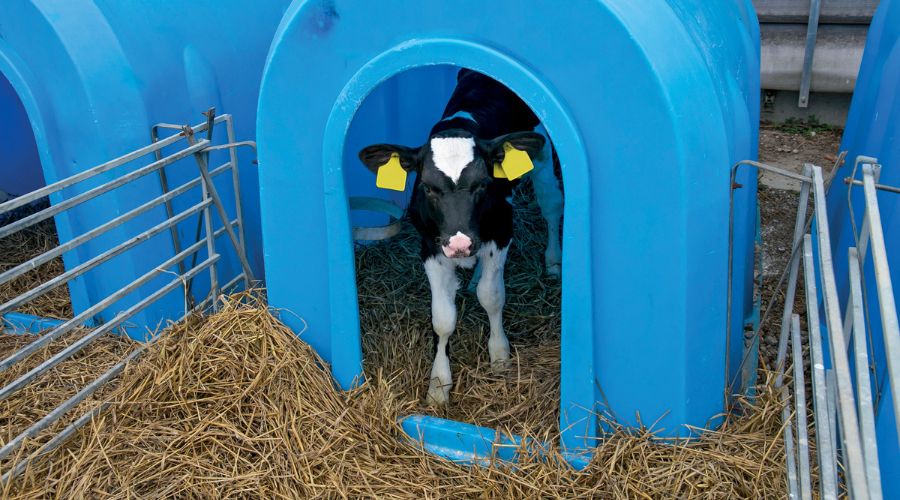Maximising calf health this spring
6th February 2025
Experts shared their advice for optimising calf health through vaccination and housing space during a recent Teagasc webinar.

Kicking off the Teagasc DairyBeef 500 webinar, MSD ruminant veterinary area manager Emma Sargent emphasised the importance of cow nutrition on colostrum quality, calf birth weight and immunity. If body condition score is too low (<3), it can lead to poorer colostrum quality and a smaller, weaker, immunosuppressed calf.
On the other hand, a BCS over 3.5 can lead to prolonged calvings requiring assistance and a calf that lacks vigour and doesn’t suckle so well. Over conditioned cows producing large volumes of milk can also dilute the colostrum.
Meanwhile, good hygiene promotes udder health and quality colostrum/transition milk, as well as bringing less disease into the calving pen and reducing the risk of contaminating colostrum.
Blood testing, silage testing and cow collars can all give useful indications regarding calf health and nutrition. As each farm is different, Emma advised speaking to your vet or farm advisor for advice.
Calf health – vaccination
Vaccination is also part of the puzzle, alongside the above factors, she added. The dry period, when colostrum is being generated, is optimal for certain cow vaccinations. Calving time is also highly stressful which increases the risk of disease being shed by the cow – so vaccinations for rotavirus and IBR, for example, should be done in advance.
Some simple factors for maximising vaccine efficacy are often overlooked, she added, such as proper storage, mixing and administration.
MSD vaccines that are suited to the dry period include:
Bovilis IBR Marker Live: A single 2ml dose (intramuscular or intranasal). For calves under three months, it must be given intranasally. Onset of immunity is four days for intranasal and 14 days for intramuscular; and lasts for 6–12 months.
Bovilis Cryptium: A mineral oil vaccine for Cryptosporidium parvum, 2ml subcutaneous. When given for the first time, two doses are needed 4–5 weeks apart in the 12–3-week period before calving. Thereafter, only one dose is needed. Alongside the first feed, at least five days of transition milk should be given.
Bovilis Rotavec Corona: Protects against rotavirus, coronavirus and E. coli scours. A 2ml intramuscular or subcutaneous vaccine given in the 12–3-week period prior to calving. It can be given at the same time as the Bovilis Cryptium.
Calf health – housing space
Stuart Childs, Teagasc dairy specialist, stressed the importance of space when it comes to calf health. Floor space should be a minimum of 1.5m2 for calves under three weeks of age, or 1.7m2 for calves under 70kg (2m2 is recommended). Air space should be at least 7m3 per calf, which is important for clearing pathogens out.
He warned that as calves stay on farm for longer now, more space may be required than in the past. He gave the example of a farm calving 65% of the herd in six weeks with a 20–25% replacement rate and bull and beef calves moving after two weeks. In a 100-cow scenario this would mean calf numbers would peak at 39 around 5th March, with 66m2 floor space and 273m3 of air space needed.
If the farm moved to a 90% six-week calving rate, there would be a peak of 52 calves on 26th February, and space requirements would increase to 88m2 floor space and 363m3 air space.
“This is important, as if we have improved our six-week calving rate in the last number of years, we may actually find that we’re a little bit short on space so we need to calculate what space we have available and examine if we have sufficient amounts to deal with the calves coming at us,” Stuart commented.
In another example, with all the same parameters as above, except with the age of sale being four weeks rather than two, the first farm calving 65% would then have similar space requirements to the farm calving 90%. In this case, 88m2 floor space and 362m3 air space would be needed. If 90% of the herd was calved within six weeks, and the age of sale was four weeks, a significant uplift in space would be needed: 123m2 floor space, and 506m3 air space.
For those short on space, without any sheds that could be repurposed for calves, Stuart recommended alternative options such as calf hutches or igloos. The most important thing is not to compromise on space, he concluded.


